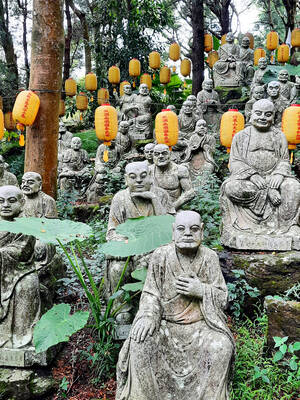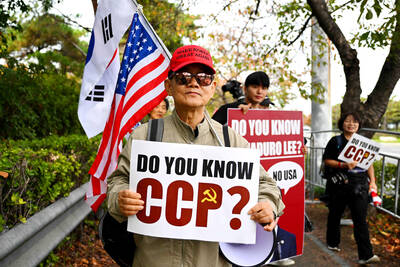The territory covered by a “cultural guide” can be both vast and devious. There are subtleties to navigate, generalizations to make, and, to be sure, a lot of space to cover. Amy Liu gallivants through this tricky terrain with gusto. Taiwan A to Z, The Essential Cultural Guide is at once a dictionary, menu, sociology text, travel guide, history, brochure and easy read. Mostly, it’s the inside scoop in manageable doses, alphabetized, too.
Make no mistake, Liu writes about her beloved island through a rose-tinted pane — not that this makes her accounts any less appetizing; she knows the way to the heart is through the stomach. F is for “Friendly Taiwanese,” a gimmicky chapter that may be difficult to digest (more on that later), but also for “Fruit Paradise,” a mouthwatering compilation ranging from wax apples to star fruits.
Liu’s guide entices readers with the best of Taiwanese cuisine, from pearl milk tea (珍珠奶茶) to fantuan (飯糰), or sticky glutinous rice rolls, to eight different varieties of dumplings. As for xiao chi (小吃), or snacks, Liu guides visitors to the homes of signature dishes: Hualien for mochi (麻糬), Keelung for tempura, Shenkeng for stinky tofu. To eat Taiwanese fare, Liu offers a chapter on using the country’s utensil of choice, though it may be difficult to translate the painstaking directions into actual skill with chopsticks.
Equally tricky to grasp may be mannerisms intuitive for native Taiwanese, but Liu treats these more subtle aspects of culture with good humor. “I” is for “Indirect Communication — How Taiwanese express themselves.” “The Taiwanese value indirect communication and they don’t spell out everything,” Liu writes, before translating a few phrases. “Yes,” for example, frequently means “I hear you” and is more popular than the only reluctantly uttered “no.”
The “Etiquette” chapter is perhaps the guide’s most practical. Caveats against impaling a bowl of rice with chopsticks (only done at funerals) or proffering business cards with only one hand are valuable tidbits. Some rules stem from common sense — don’t pick up food then put it back in the dish — but others — do not use chopsticks to spear food and don’t write on someone’s business card (it represents their face) — could be a newcomer’s saving grace.
Other must-reads fall under P, for “People of Taiwan,” which gives a broad overview of the island’s history and demographics, or under B, for “Betel Nut Beauties,” Taiwan’s notorious hawkers of the chewable nut popular for its tobacco-like buzz, as well as of revealing marketing strategies. Handy details are scattered here and there. Ganbei (乾杯), for example, means “bottoms up” and should be uttered with the generous toasting inevitable at formal business dinners.
If the guide does not shy from generalization, it also isn’t burdened by the need to dissect all its claims. It must be said, however, that characterizations such as, “ABCs by and large are well-educated, energetic, adventurous, and independent,” are startling, to say the least. It might be better to encounter “Friendly Taiwanese” in person, rather than in words stating, “Indeed the general impression … is that the Taiwanese are, among other things, friendly, polite, hard-working, kind, passionate, easy-going, reliable, open, and flexible.”
Liu’s social studies are her most ambitious. For the most part, it boils down to “Westerners value individualism, while Taiwanese respect group-orientation.” In “Identity, ‘I’ or ‘We’ — it all starts from the nursery.” Liu describes the difference between Taiwanese parents, who sleep in the same room or even bed as their children (sometimes at the price of the father’s exile to another room) versus Western families, who often have their babies sleep alone starting on the first day in order to instill independence.
She writes of Western culture, “The ‘self-identity’ — (I, me, my) and the need to stand out from the crowd and be different is considered desirable” and contrasts this with Taiwanese who “identify closely with the group … All aspects of personal and professional life, including relationships, are connected and intertwined for everyone who is considered part of the group. The desires of the ‘self’ cannot be separated from the wishes of the group and the family.” At the same time, Liu explains, “Taiwanese people are group-oriented … however, they are generally not good at teamwork,” attributing this to a culture of fierce competition that extends into offices and classrooms alike, thus the unusually high number of university degrees and PhDs found on the island.
Liu writes that her inspiration stems from seeing both her brother’s child raised in Taiwan as well as her sister’s children brought up in the US. She herself is, in her own terms, a “Returning Taiwanese,” having emigrated to the US from Taipei when she was 13. It’s perhaps these double-sided perspectives that lend the book the familiarity of an insider and its accessibility to those who are not.
Liu’s guide aptly compiles the lessons newcomers might otherwise learn over a period of time, through observation and conversations. It’s less draining than an academic paper and more reliable than a tourist’s brochure, and it’s accompanied by glossy, full-page color photos. Of course, cultural guides tend to be rendered out of date as quickly as iPod models, but for the time being, Liu’s guide will help readers with their first steps in Taiwan.

US President Donald Trump may have hoped for an impromptu talk with his old friend Kim Jong-un during a recent trip to Asia, but analysts say the increasingly emboldened North Korean despot had few good reasons to join the photo-op. Trump sent repeated overtures to Kim during his barnstorming tour of Asia, saying he was “100 percent” open to a meeting and even bucking decades of US policy by conceding that North Korea was “sort of a nuclear power.” But Pyongyang kept mum on the invitation, instead firing off missiles and sending its foreign minister to Russia and Belarus, with whom it

When Taiwan was battered by storms this summer, the only crumb of comfort I could take was knowing that some advice I’d drafted several weeks earlier had been correct. Regarding the Southern Cross-Island Highway (南橫公路), a spectacular high-elevation route connecting Taiwan’s southwest with the country’s southeast, I’d written: “The precarious existence of this road cannot be overstated; those hoping to drive or ride all the way across should have a backup plan.” As this article was going to press, the middle section of the highway, between Meishankou (梅山口) in Kaohsiung and Siangyang (向陽) in Taitung County, was still closed to outsiders

President William Lai (賴清德) has championed Taiwan as an “AI Island” — an artificial intelligence (AI) hub powering the global tech economy. But without major shifts in talent, funding and strategic direction, this vision risks becoming a static fortress: indispensable, yet immobile and vulnerable. It’s time to reframe Taiwan’s ambition. Time to move from a resource-rich AI island to an AI Armada. Why change metaphors? Because choosing the right metaphor shapes both understanding and strategy. The “AI Island” frames our national ambition as a static fortress that, while valuable, is still vulnerable and reactive. Shifting our metaphor to an “AI Armada”

The Chinese Communist Party (CCP) has a dystopian, radical and dangerous conception of itself. Few are aware of this very fundamental difference between how they view power and how the rest of the world does. Even those of us who have lived in China sometimes fall back into the trap of viewing it through the lens of the power relationships common throughout the rest of the world, instead of understanding the CCP as it conceives of itself. Broadly speaking, the concepts of the people, race, culture, civilization, nation, government and religion are separate, though often overlapping and intertwined. A government